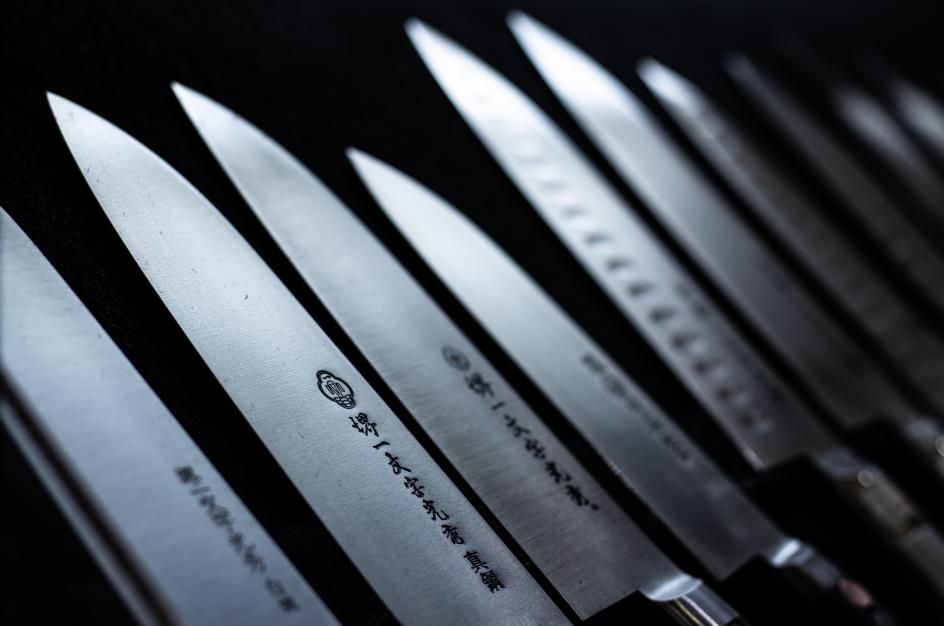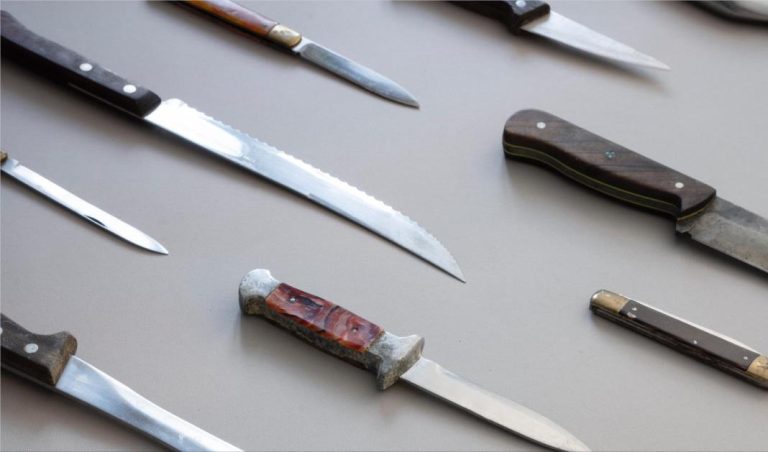Steel is today’s standard knife blade material. Even though most knives are made from steel, there are different varieties. Carbon steel and stainless steel are the two most commonly used types of steel for knifemaking. They are similar in many ways, but vital differences set them apart.
Here is everything you need to know about the differences between carbon steel and stainless steel.
What is carbon steel?
Carbon is the primary alloy in steel. All steel has carbon to a certain degree. Some have more; some have less, but the usual scope is between 0.40 to 1.20%. Any steel with over 0.60% carbon content by weight is categorized as high carbon steel.
There are specific steels catered for certain purposes that contain significantly more or less than the above range. Knife manufacturers pick the steel they use accordingly to meet their customer’s needs. For example, carbon amount won’t be needed as much if corrosion resistance is a priority – more on why it works like this below.
What does carbon do to steel?

Carbon is the primary alloy in steel. Take iron and add carbon; you’ll basically have steel. Adding carbon is what differentiates iron from steel.
Carbon increases hardness and hardenability. It turns iron into a stronger piece of metal, perfect for making knives. As the carbon amount increases, so do the steel’s hardness and wear resistance, among other things.
However, simply adding more carbon doesn’t only lead to positive outcomes. The hardness and brittleness also increase simultaneously. This can make the steel less durable and susceptible to damage.
Low, mid, and high carbon steel
The steel’s carbon amount drastically changes its properties. That’s why there isn’t a single type of carbon steel. In a way, we can categorize them based on their carbon content.
As mentioned above, steel with 0.60% or more carbon content is considered high-carbon steel. Steel with 0.30 to 0.59% carbon content is medium carbon steel. Any steel less than 0.30% is low-carbon steel.
The low and medium carbon steels are highly favorable for making stainless steel knives. When the same amount of chromium is added to low and medium carbon steel, it improves corrosion resistance more than high carbon steel.
On top of everything discussed about high carbon steel, it’s still a broad concept. Steel with more than 0.60% carbon would be high carbon, but additional alloys also matter. Other alloying elements can have a suppressing influence on the steel’s effects, for example, chromium.
What is stainless steel?

Let’s look at how stainless steel is different from carbon steel.
Carbon steel can be stainless by adding chromium to it. However, the present carbon amount is a crucial factor that determines the steel’s ability to resist corrosion. True stainless steel doesn’t have as much carbon. For example, 3cr13 steel, a highly corrosion-resistant Chinese steel, has just 0.30% carbon with 14.00% chromium.
Another good example is the X50CrMoV15 German steel with 0.55% carbon and 15% chromium. The amount of chromium proportionate to the present carbon levels make these steels resist corrosion incredibly well.
What does chromium do to steel?
Chromium is essential for steel to become stainless. It’s naturally resistant to corrosion and creates a chromium oxide layer on the surface of the steel, known as the passive layer. This layer of chromium oxide protects the steel from oxidizing, preventing it from rusting.
Chromium doesn’t just make steel stainless. It also improves the hardenability and toughness of the steel though it’s very brittle by itself.
High carbon stainless steel
Carbon steel doesn’t resist corrosion as much by nature compared to stainless steel. It tends to develop a patina with use that protects the surface area from further oxidation. Patina is how carbon steel resists corrosion without other alloying elements.
High carbon stainless steel resists rusting better than high carbon steel. However, steelmakers then need to sacrifice carbon to achieve better corrosion resistance. Simply adding more carbon and chromium doesn’t produce strong steel with incredible corrosion resistance. Some steel has up to 20% chromium, but with already high carbon amounts, they can’t resist corrosion as much.
Usually, these steels have underperforming corrosion resistance than carbon steel with less chromium. For example, D2 steel has around 1.50% carbon with 12% chromium. Compared to ZDP-189 steel, which has 20% chromium but also 3%carbon, D2 steel performs better in corrosion resistance.
It’s more about the chromium to carbon ratio that defines rust resistance rather than the actual chromium content. Carbon has a suppressing effect on chromium’s ability to resist corrosion. For that reason, better-performing stainless steels usually have less carbon.
Overall, high carbon stainless steel is between stainless steel and high carbon steel. Knifemakers use these types of steel to provide good edge retention with adequate corrosion resistance to their customers.
Carbon steel vs. stainless steel knife
Here is the part where we differentiate carbon steel and stainless steel in knives.
As mentioned above, stainless steel knives come with a lower amount of carbon than carbon steel, especially compared to high carbon steel. This impacts hardness and influences the blade’s performance, from how long it stays sharp to durability.
Edge retention

Usually, the more carbon the steel has, the harder it is. Since this is vital for edge retention, stainless steel knives stay sharp for lesser periods.
All knives get dull with use. An average user may not mind the occasional sharpening, but a professional surely will. Someone who’s outdoors frequently cutting wood to start a fire or a chef working in a restaurant will notice their blades losing sharpness faster. That’s why carbon steels are highly favored for their edge retention by professionals.
The trade-off of looking after a knife to prevent rusting in exchange for a sharp edge that cuts for prolonged periods make sense to professionals. It’s the opposite for an average user getting less than an hour a day from their knives.
In edge retention, carbon steel is an obvious winner. When corrosion resistance is critical, high carbon stainless steel can provide it adequately with proper edge retention.
Corrosion resistance
The obvious winner is stainless steel. Nonetheless, it isn’t to say that carbon steel gets rust built up immediately when you neglect care. Over a while, it surely will rust, but it won’t happen as spontaneously as one might think.
As briefly mentioned, carbon steel develops a patina on the surface. It’s similar to how chromium oxide covers the steel’s surface. Both are there to block further oxidization from oxygen and moisture, but chromium oxide accomplishes this significantly better.
With minimal yet effective care techniques, such as drying the knife when not used, coating the blade with mineral oil, and hand-washing and wiping it dry, carbon steel doesn’t rust. When there is a continuous neglect in care, carbon steel knives can rust on their users.

How long a knife stays sharp is important, but it will dull eventually. That’s why the ease of sharpening is a vital factor to consider. However, simply saying carbon steel or stainless steel is easier to sharpen would be wrong. Sharpening is largely related to the steel’s wear resistance and other factors.
The wear resistance of steel influences sharpening because of material loss. Steel with good wear resistance resists losing material better, making it more difficult to sharpen the blade.
On the other hand, steel’s chemical makeup can influence sharpening. For example, stainless steel with high vanadium content will be significantly harder to sharpen than carbon steel. This is because vanadium carbides are harder than aluminum oxide and silicon carbide, the two main chemical compounds of sharpening stones.
While these are considerable points, carbon steel is usually easier to sharpen. Sure, carbon steel has better wear resistance than stainless steel, but it also has fewer alloying elements that don’t produce as many carbides. Since sharpening requires grinding the blade’s edge to remove material, there is less pushback with carbides. These make carbon steel easier to sharpen than stainless steel.
Price
There are more stainless steel knives than carbon steel knives. When knifemakers want to produce kitchen knives or pocket knives in mass, they don’t forge them individually. Instead, they cut the blade shape from a sheet of steel, heat treat, grind, and assemble a handle. These are stamped knives. This fast manufacturing process makes them more affordable, but it doesn’t produce the quality of a hand-forged knife.
Since there is intensive labor that goes into hand-forging a knife blade, they turn out to be more expensive. Even though stainless steel is costlier, the knives made from them are likely to be cheaper than carbon steel knives. Still, the same can be done with carbon steel. It isn’t just as preferred for stamped knives due to poor machinability and higher hardness.
Carbon steel, especially high carbon steel, is a favorite for hand-forged knives. Blacksmiths can make a knife blade that performs incredibly well using carbon steel. These usually make carbon steel knives more expensive than stainless steel knives despite being cheaper as a raw material.
Buy Wholesale Knives and Start Scaling up with Us Today
Contact us and connect with a sales rep to get a free quote.
Popularity
Since knowing their knives won’t rust is a vital consideration for most people, stainless steel is a lot more popular. As long as it does the job without breaking or rusting, it’s the ideal knife material.
Stainless steel knives are low-maintenance. They don’t require the user to take additional steps to care. It’s different with carbon steel knives. Even though the care requirements aren’t too demanding, it can get frustrating for some.
Although these make stainless steel knives significantly more popular, professionals and frequent knife users will put other things above corrosion resistance. If the knife is a vital tool used every day multiple times, upkeeping will be a part of the daily routine anyways. That’s why carbon steel knives are more appealing to those that use knives continually.
Comparison table
| Carbon Steel | Stainless Steel | |
| Edge Retention | Excellent edge retention and sharpness. | Mediocre to adequate edge retention due to softness. |
| Corrosion Resistance | Poor corrosion resistance | Excellent corrosion resistance. Some stainless steel never rusts. |
| Sharpening Ease | Easier to sharpen. | Could be easy or hard to sharpen depending on the alloying elements. |
| Price | Cheaper | More expensive |
| Popularity | Favored by knife enthusiasts | Favored by average users wanting a simple and effective product |
| Target Customers | Professional chefs and frequent users | Home cooks and occasional users |
Should I consider selling stainless or carbon steel knives?
Sell stainless steel knives if
- you want to appeal to a wide range of consumers.
- selling kitchen cutlery to home cooks.
- the customers favor corrosion resistance more than other features.
Sell carbon steel knives if
- corrosion resistance isn’t the main priority in the industry.
- you anticipate selling to professionals and frequent users of knives.
- sharpness and how long that sharpness stays are vital for your customers.
These are a few examples to help you decide which one is better for your customers. Still, market research is key. If your customers require corrosion resistance, picking carbon steel won’t be reasonable. When corrosion resistance isn’t essential, they’d be happier with a sharper and more sustainable edge.
Need assistance? We supply OEM and ODM services to our partners, whether dropshipping or selling knives in their stores, with private labeling, global shipping, and inventory. Contact us to request a quote for the knives you have in mind.










